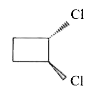Which of the following alkanes is optically active ?
3-methyl hexane
propane
2,3, 4-trimethyl pentane
2-methyl butane
The correct Answer is:A
To determine which of the given alkanes is optically active, we need to identify if any of them contain a chiral carbon atom. A chiral carbon is a carbon atom that is bonded to four different groups, leading to non-superimposable mirror images (enantiomers).
1. Identify the Alkanes: The options given are:
- A) 3-methylhexane
- B) Propane
- C) 2,3,4-trimethylpentane
- D) 2-methylbutane
2. Analyze Each Alkane for Chirality:
- Option A: 3-methylhexane
- Structure: The main chain is hexane, and at the 3rd carbon, there is a methyl group.
- Check for chiral carbon: The carbon at position 3 is bonded to:
- A propyl group (from the hexane chain)
- A methyl group
- A hydrogen atom
- A butyl group (the rest of the hexane chain)
- Since all four groups attached to this carbon are different, this carbon is chiral. Therefore, 3-methylhexane is optically active.
- Option B: Propane
- Structure: Propane has three carbon atoms.
- Check for chiral carbon: All carbons in propane are either bonded to hydrogens or are part of the same alkyl group.
- There are no carbons with four different substituents, so propane is optically inactive.
- Option C: 2,3,4-trimethylpentane
- Structure: This alkane has a pentane chain with three methyl groups at positions 2, 3, and 4.
- Check for chiral carbon: The carbons at positions 2 and 3 are bonded to two identical methyl groups.
- Since there are no carbons with four different substituents, this compound is optically inactive.
- Option D: 2-methylbutane
- Structure: This alkane has a butane chain with a methyl group at position 2.
- Check for chiral carbon: The carbon at position 2 is bonded to:
- A methyl group
- A butyl group (the rest of the butane chain)
- Two hydrogen atoms
- Since there are two identical hydrogen atoms, this carbon is not chiral, making 2-methylbutane optically inactive.
3. Conclusion: The only alkane that is optically active is 3-methylhexane (Option A).
Final Answer:
A) 3-methylhexane is the optically active alkane.
- A) 3-methylhexane
- B) Propane
- C) 2,3,4-trimethylpentane
- D) 2-methylbutane
- Option A: 3-methylhexane
- Structure: The main chain is hexane, and at the 3rd carbon, there is a methyl group.
- Check for chiral carbon: The carbon at position 3 is bonded to:
- A propyl group (from the hexane chain)
- A methyl group
- A hydrogen atom
- A butyl group (the rest of the hexane chain)
- Since all four groups attached to this carbon are different, this carbon is chiral. Therefore, 3-methylhexane is optically active.
- Structure: Propane has three carbon atoms.
- Check for chiral carbon: All carbons in propane are either bonded to hydrogens or are part of the same alkyl group.
- There are no carbons with four different substituents, so propane is optically inactive.
- Structure: This alkane has a pentane chain with three methyl groups at positions 2, 3, and 4.
- Check for chiral carbon: The carbons at positions 2 and 3 are bonded to two identical methyl groups.
- Since there are no carbons with four different substituents, this compound is optically inactive.
- Structure: This alkane has a butane chain with a methyl group at position 2.
- Check for chiral carbon: The carbon at position 2 is bonded to:
- A methyl group
- A butyl group (the rest of the butane chain)
- Two hydrogen atoms
- Since there are two identical hydrogen atoms, this carbon is not chiral, making 2-methylbutane optically inactive.
A) 3-methylhexane is the optically active alkane.
Similar Questions
Knowledge Check
Which of the following compounds is optically active?
A B
B C
C D
D
Which of the following compounds is optically active?
A B
B C
C D
D
Which of the following compounds is optically active ?
A1-BromobutaneB2-BromobutaneC1-Bromo-2-methylpropaneD2-Bromo-2-methylpropane
